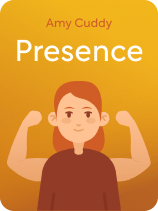

This article is an excerpt from the Shortform book guide to "Presence" by Amy Cuddy. Shortform has the world's best summaries and analyses of books you should be reading.
Like this article? Sign up for a free trial here.
How can you gain a confident body posture? Why does technology make your posture worse?
In Presence, Amy Cuddy says that you can enhance your presence by making powerful postures habitual in your daily life. Being intentional about small adjustments to your posture can build over time into drastic improvements in your confidence and ability to express yourself.
Continue reading if you want to feel self-assured through your posture all the time.
Check and Adjust Your Posture
One way to build a confident body posture long-term is to create reminders for yourself to check your posture and ensure that you’re not slouching or making yourself small. Reminders can be visual notes, alerts on your phone, or prompts from friends to adopt a relaxed and open posture, as we described earlier in the section. Cuddy says that the more time you spend intentionally exhibiting this kind of body language, the calmer and more confident you’ll feel on a daily basis.
(Shortform note: Although reminders may be a good start to increase your awareness of your posture, there are also other strategies you might consider for targeting the root causes of hunched posture. For example, a physical therapist could help you determine if your poor posture is a result of injury, a genetically inherited condition, or even the shoes you wear, which can shift your body out of its natural alignment.)
A major challenge of maintaining open body language is that when you spend much of your time looking at small screens—such as a smartphone or laptop— this naturally causes you to hunch your shoulders and tilt your head downward (a position Cuddy refers to as “iPosture”). One clinician observes that more people are developing dowager’s humps (a permanent curve in the upper back from slouching), and Cuddy’s research suggests that caved-in posture from looking at devices makes people less assertive and less proactive compared to when they have more open, confident posture.
(Shortform note: Research supports the idea that looking at mobile devices can contribute to poor posture and upper body strain. However, since musculoskeletal problems can arise from a wide range of conditions, it may be important to consider other factors that may be contributing to poor posture and subsequent changes in disposition. For example, these can include heavy lifting, doing any kind of repetitive motion, staying in the same position for long periods, overuse of certain muscles, or genetics that cause a higher risk for conditions such as arthritis.)
Cuddy’s tip for counteracting the closed-off body language that some devices encourage is to arrange your commonly used spaces to facilitate looking up and stretching out. For example, you might mount your TV high on the wall or use high shelves that you have to reach up to access.
(Shortform note: If you work on a computer for several hours at a time for your job, caved-in posture can cause chronic neck, back, and wrist pain in addition to negatively impacting your confidence. Some health experts recommend avoiding these physical stressors by making ergonomic adjustments to your office setup that are similar to Cuddy’s advice for rearranging your spaces. For instance, make sure that your chair supports your spine, position your armrests, keyboard, and computer mouse so that your shoulders are always relaxed, and keep your monitor or laptop at eye level between 20-40 inches away from you. Another habit that can help with these problems is getting up to move around at regular intervals. )
Practice Yoga and Controlled Breathing
Cuddy’s next advice for incrementally improving your presence is to practice yoga or another physical activity that involves stretching and controlled breathing. Research shows that this habit is particularly beneficial for people suffering from post-traumatic stress (PTS), who may experience debilitating anxiety, fear, self-doubt, and other feelings of powerlessness on a regular basis. Cuddy says that yoga enhances your presence—in addition to providing a myriad of other health benefits—because it activates the parasympathetic nervous system (PNS).
The PNS is essentially the opposite of the fight-or-flight response that arises when you feel threatened. When the PNS is activated, your heart rate slows and your mind and body enter a state of relaxation. According to many studies, doing yoga trains your body to resist automatic stress responses and can lead to long-lasting improvements in your self-esteem and mental well-being. And if you’re not interested in yoga specifically, taking slow, deep breaths, chanting, and meditating all have similar benefits.
(Shortform note: Activating the PNS through yoga and other relaxing activities is not only helpful for increasing your presence but also vital to your physical health. Activation of the PNS is the body’s way of entering a state where it can focus on digestion, healing, and physical rejuvenation. Some experts assert that hectic lifestyles—like being busy all the time—reduce the activity of the PNS and increase our stress response controlled by the sympathetic nervous system (SNS). When the SNS is overactive, this imbalance can result in insomnia, digestive problems, and chronic inflammation. This stress response may also explain why people with PTSD have a higher risk of physical health problems in addition to mental health symptoms.)

———End of Preview———
Like what you just read? Read the rest of the world's best book summary and analysis of Amy Cuddy's "Presence" at Shortform.
Here's what you'll find in our full Presence summary:
- How to navigate social situations, interviews, performances, and more
- The research behind power poses, and how to use them effectively
- Body language you should avoid so others won't resent you






